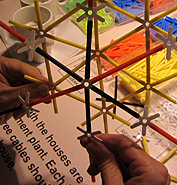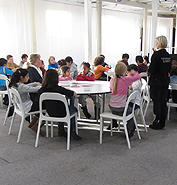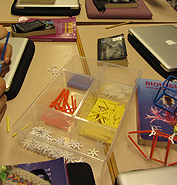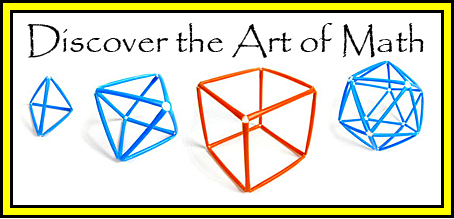2016 News Archive
Here you can read reports and news for the current year. We update the news page
as soon as something new and exciting has happened or is planned for. The posts are
listed in chronological order: with the latest news first and the oldest last. Everything
written on this page is archived year by year (see archive below) so you can always
go back and find information from the past.
Archive: 2015 2014 2013 to 2009
11 April 2016
"Enlightening Imagination" competition
"Enlightening Imagination" is a competition to encourage students to solve problems
and put their ideas into practice in a creative way with the help of 4DFrame; an
educational teaching material developed in South Korea. Each team, consisting of
two students, receives a well-defined mission. The goal is clearly formulated and
the evaluation criteria are based on technical solutions, creativity, artistic level
and interpersonal skills.
The assignment has to be solved in 1.5 hours, and will be presented as a short description,
a simple sketch and a 4DFrame model. Each group will describe and demonstrate how
they have used their technical and mathematical thinking.
Listed below are links to the six science centers and the one KomTek in Sweden that
will arrange the competition "Enlightening Imagination" in 2016. In many places,
you have the opportunity to train for the competition. You are welcome to contact
us, or any of the following contest organizers:
Framtidsmuseet, Borlänge - 29 April 9.30 – 11.30
Innovatum, Trollhättan – 12 May 9.30 – 11.30
KomTek, Alingsås – 10 May 9.30 – 11.30
Tekniska Museet, Stockholm – 10 May 9.30 – 11.30
Teknobalder, Skellefteå – 12 May 9.00 - 12.00
Umevatoriet, Umeå – 12 May 9.30 – 11.30
Vattenhallen, Lund – 13 May 9.00 – 12.00
26 February 2016
“Using 4DFrame shows proven results in two informal learning studies”
Two scholarly articles published in educational journals last year (for citations,
see after the text) have shown that a traveling science centre exhibit that included
a 4DFrame hands-on workshop showed a real increase in student learning in such an
informal educational setting that were better than expected. Data for the two studies
came from the “Discover the Art of Math” (DAM) exhibit that was traveled to several
science centers in both Latvia and Sweden. Each installation had its own 4DFrame
workshop where exhibit participants—both from visiting school classes and the general
public—had the opportunity to use the material.
In the case of these two articles, nearly 800 12-year old students—almost equally
divided between boys and girls—took part in a program of pre- and post-visit testing
in association with their visit to the DAM exhibit. The actual time spent in the
exhibit itself was divided up into two parts; the first consisted of 45-minutes among
eight interactive “hands-on” exhibition objects that the students were allowed to
explore and interact with on their own and in their own way during the allotted time.
Following this, they spent 45-minutes in the 4DFrame workshop part of the exhibit
building their own three-dimensional structures and creations using this educational
material’s colorful multi-length tubes and different types of connectors used to
attach the tubes to one another. One of the things that they could perform was to
build concrete geometrical models and other physical structures based on abstract
instructions; for example, build a 3D box based on starting off with a 2D square.
While much has been written anecdotally about the value of informal learning in such
places as museums and science centres (even planetariums), there has been little,
or no, evidence from formal studies that education in such venues has taken place.
One of the important outcomes of the post-visit tests from this study does in fact
show that learning actually had taken place in DAM in such informal learning situations.
Both boys and girls—there was no gender difference in the results—showed an increase
in what they knew immediately after visiting the exhibit as well as following a period
of time (about seven to 11 days depending on the class) when the experience was no
longer current.
Another interesting outcome was that those who had the poorest results in the pre-test
actually improved their results on the post-test, a clear indication that informal
learning can be a valuable tool for providing learning opportunities for the weakest
learners who may not respond well in a traditional school setting. It could only
be hoped that after being inspired by the improvements gained, and their increased
self-esteem following their visit to the informal learning environment of a museum
or science centre, that they would find new interest in their school’s more formal
setting.
In the final analysis, the results were encouraging enough to continue along these
lines in future investigations on the effectiveness of educating via informal learning
environments. And the use of 4DFrame educational materials in such a setting certainly
played a part in motivating the student’s natural curiosity as well as their aesthetic
sensibility, leading to higher interest and learning for both boys and girls.
Article citations:
- H. Salmi, M-P. Vainikainen and H. Thuneberg (2015). “Mathematical thinking skills,
self-concept and learning outcomes of 12-year-olds visiting a Mathematics Science
Centre Exhibition in Latvia and Sweden” Journal of Science Communication 14 (04),
A03.
- Mari-Pauliina Vainikainen, Hannu Salmi, Helena Thuneberg (2015). ”Situational Interest
and Learning in a Science Center Mathematics Exhibition” Journal of Research in STEM
Education. 1(1), 15-29
Link to the “Discover the Art of Math” site
Top of page
©2013-2020, Nordic4DFrame AB
Grönviksvägen 6, 185 41 Vaxholm, Sweden






